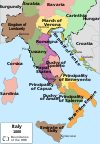Rothari: Difference between revisions
added king of italy list |
|||
| Line 24: | Line 24: | ||
{{s-aft|after=[[Rodoald]]}} |
{{s-aft|after=[[Rodoald]]}} |
||
{{end}} |
{{end}} |
||
{{Antique Kings of Italy}} |
|||
[[Category:652 deaths]] |
[[Category:652 deaths]] |
||
Revision as of 05:54, 4 April 2008
Rothari of the house of Arodus was king of the Lombards from 636 to 652; previously he had been duke of Brescia. He succeeded Arioald, who was an Arian like himself, and was one of the most energetic of Lombard kings. Fredegar relates (Chronicle, 71) that at the beginning of his reign he put to death many insubordinate nobles, and that in his efforts for peace he maintained very strict discipline.
Rothari conquered Genoa in 641 and the rest of Byzantine Liguria in 643. He conquered all remaining Byzantine territories in the lower valley of the Po, including Oderzo (Opitergium). According to Paul the Deacon, "Rothari then captured all the cities of the Romans which were situated upon the shore of the sea from the city of Luna in Tuscany up to the boundaries of the Franks." (IV.xlv)
With these quick conquests, he left the Byzantines with only the Ravennan marshes in northern Italy. The exarch of Ravenna, Plato, tried to regain some territory, but his invading army was defeated by Rothari on the banks of the Scultenna (the Panaro) near Modena, with the loss of 8,000 men, in 642.
Rothari's most lasting act was drawing up the eponymous Edictum Rothari which was the first written codification of Lombard law (it was written in Latin). He convened a gairethinx to affirm this new and improved collection of old tradition in 642 or 643. The edict only covered his Lombard men and subjects: Romans continued to live under Roman law in Lombard jurisdictions.
He was succeeded by his son Rodoald.
Triva
- A baptistery in Monte Sant'Angelo, Puglia, southern Italy, is traditionally known as the "Tomb of Rothari".
References
- Paul the Deacon, Historia Langobardorum IV.xlii and xlv ( English translation by William Dudley Foulke, 1907)

